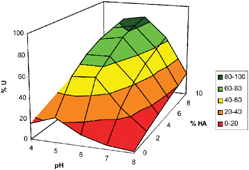Uranium speciation in moorland river water samples: A comparison of experimental results and computer model predictions
Abstract
An on-line method has been developed for separating inorganic and organic bound uranium species present in river water samples. The method utilised a small chelating resin (Hyphan) column incorporated into the sample introduction manifold of an ICP-MS instrument. The method was evaluated for samples from rivers on Dartmoor (Devon, UK), an area of granite overlain with peat bogs. The results indicate that organic-uranium species form a major proportion (80%) of the total dissolved uranium present. Further work with synthetic water samples indicated that the level of dissolved organic carbon played a greater role in determining the level of organic-uranium species than did sample pH. Computer models for the water samples were constructed using the WHAM program (incorporating uranium data from the Nuclear Energy Agency Thermochemical Database project) in order to predict the levels of organic-uranium species that would form. By varying the proportion of humic and fulvic acids used in the humic component, predictions within 10% of the experimental results were obtained. The program did exhibit a low bias at higher pH values (7.5) and low organic carbon concentrations (0.5 μg ml−1), but under the natural conditions prevalent in the Dartmoor water samples, the model predictions were successful.


 Please wait while we load your content...
Please wait while we load your content...